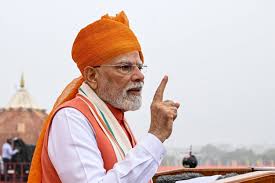
Modi Announces Tax Relief to Boost India’s Economy Amid Trump Tariff Tensions

 :
| Updated On: 20-Aug-2025 @ 3:21 pm
:
| Updated On: 20-Aug-2025 @ 3:21 pmSHARE
On Monday, Indian financial markets saw a notable rally following Prime Minister Narendra Modi’s announcement of tax cuts, aimed at supporting domestic consumption amid ongoing U.S. tariff pressures. The Nifty 50 index rose by 1%, while the BSE Sensex gained 0.84%. In the currency market, the U.S. dollar weakened by 0.18% against the rupee.
The surge comes in the wake of Modi’s extensive Independence Day address, during which he emphasized self-reliance and outlined a series of fiscal reforms. One of the key proposals involved revamping the Goods and Services Tax (GST) system by introducing a simplified two-tier structure of 5% and 18%, replacing the previous 12% and 28% levies on selected items. According to government officials, these reforms are designed to streamline compliance, reduce tax burdens, and modernize the GST framework to better support economic growth.
The India Brand Equity Foundation highlighted that the measures are expected to benefit sectors such as manufacturing, logistics, housing, and consumer goods. By rationalizing rates into two slabs, easing taxes on micro, small, and medium enterprises (MSMEs), and cutting levies on essential goods, the reforms aim to stimulate investment. Technology-driven processes, such as pre-filled returns and faster refunds, are also expected to make compliance easier and more efficient.
India’s automotive sector is among the anticipated beneficiaries. After a period of slow growth, passenger vehicle sales—including cars—grew by 4.2% in 2024, marking the slowest pace in four years. Stocks in the auto sector responded strongly to the announcement, with Maruti Suzuki India rising 8.75% and Hyundai Motor India climbing 8.15%. Market analysts, including James Thom of Aberdeen, noted that the announcement could help the relatively underperforming auto sector recover, boosting investor confidence.
Modi’s tax reforms are poised to strengthen India’s broader economy. The Reserve Bank of India forecasts a 6.5% GDP growth for the 2025–2026 fiscal year, despite geopolitical uncertainties arising from U.S. “reciprocal tariffs” and additional levies on Indian imports, particularly Russian crude. Analysts have emphasized that India’s economy is primarily driven by domestic consumption rather than exports, making GST reforms particularly impactful in countering external tariff pressures.
Consumption remains a critical driver of India’s economic growth, contributing 61.4% to GDP in 2024–25. Urban consumption and shifts toward luxury goods are emerging as significant growth pillars. Deloitte and other analysts note that reforms and lower inflation—retail inflation fell from 4.31% in January to 1.55% in July—are expected to further support stable consumption growth in FY26. India Ratings & Research projects private final consumption will grow by 6.9% by the end of March 2026, exceeding the broader GDP growth projection of 6.3%.
Overall, the tax overhaul is viewed as a strategic intervention to stimulate domestic demand, encourage investment, and bolster key sectors, particularly in the context of global trade tensions. By easing compliance, reducing rates, and fostering technological efficiencies, the reforms provide immediate relief to businesses and households while promoting longer-term growth and stability. The combination of fiscal reforms, rising consumer spending, and controlled inflation is anticipated to positively influence the Indian economy and sustain momentum in domestic markets.